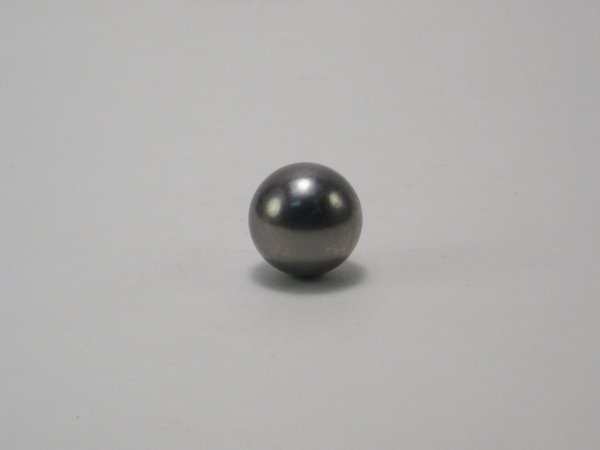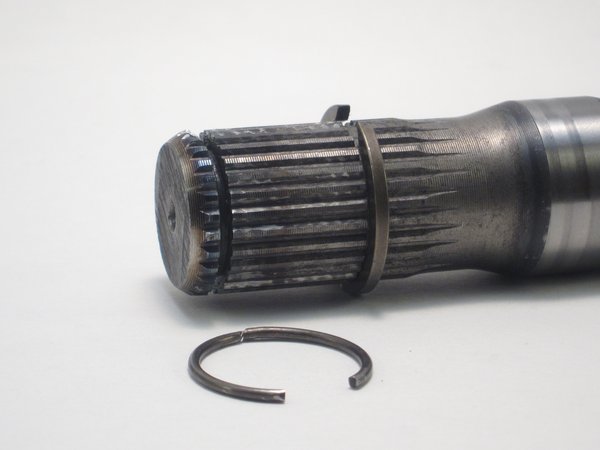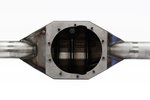All About Stock Toyota Birfields

Here is a breakdown of the parts of a stock Toyota front axle Birfield.
The axle in this article is a short-side Birfield from a '79-'85 Toyota pickup. Keep in mind that different models of Toyotas have may have different Birfield dimensions. Some parts are interchangeable; some are not.
The next time someone says, "I blew up the bell," or "I snapped the short side inner shaft" you'll know what that means.
We'll start from the hub side of the axle and work our way into the carrier.
- Can I Drive On a Broken Birfield?
- Toyota Birfield Upgrades: All About Chromoly, 30 Splines, and Fit For Minis, Pickups, 4Runners, and Land Cruisers
Wide side/Narrow side
Wide chamfered side/Narrow chamfered side
Both of the above
Orientation
We're going to talk about stock Birfields, list specs on them for different Toyotas, and show you the parts and how they go together. If you want to know about stronger Birfields, read our article on upgrading Birfields. From there we have links to model-specific Birfield upgrades and ALL axle kit listings from every manufacturer with specs.
Birfield axleshafts have two main shafts, the inner and the outer. Inner means towards the center of the vehicle, where the engine is. Outer means towards the outside of the vehicle, where the tires are. So the Birfield bell is also called the "outer axleshaft" and the "inner axleshaft" is the one that mates with the differential.
Be extra cautious when referring to your manual! When you are specifically working on the Birfield bell and joint parts, some manuals will say "face out of the bell" or something to that effect. But the manual's "out of the bell" is the same as our "inner", since the outside of the bell faces the inside of your truck. It's really important to understand this distinction especially because you might install the cage or star the wrong way around if you have a disassembled axle.
Clearing up some spline-count confusion
One of the biggest points of confusion with Toy shafts are the spline counts. There are two sets of confusing terms:
1) Coarse vs. fine spline
Early Land Cruisers had "coarse spline" axles and later model Cruisers had "fine spline" axles. In this context, coarse and fine refer to the spline count at the hub, which was 6 spline on early Birfields and 30 spline on later Birfields.
There are also fine and coarse spline pinions in Cruisers and that's a different topic. So, in this article, we are not referring to the pinion in the differential at all.
27 spline vs. 30 spline
It's pretty common to upgrade from "27 spline axles" to "30 spline axles", but many people don't know where the spline counts come from. In fact, "27 spline axles" and "30 spline axles" refer to the spline count inside the Birfield joint, not at the hub or differential.
Unless you have an early model Toyota Land Cruiser, your axles will have 30 splines at the carrier and 30 splines at the hub.
Check out our chart down below to see what spline counts your axle really has.
Toyota Birfield Variations
There are several Toyota Birfield variations. This chart is primarily for US vehicles. If you spot an error or have something different than our chart, please let us know so we can improve it! Please note: If you're planning to swap Birfields from axle to axle, inner and outer axleshafts lengths vary. This can have important implications, especially if you plan to upgrade your axleshafts in the future. Aftermarket axleshaft makers may only make a shaft size that fits a particular generation. If this is true for your vehicle, you may need to swap parts (like locking hubs) in order to meet the length of your new shafts. Pay attention to manufacturer instructions!
| Birfield type | Years | Vehicle | Hub splines | Star (inner race) splines | Inner axle hub-side splines | Inner axle differential splines | Bell size | Brakes | Notes |
|---|---|---|---|---|---|---|---|---|---|
| Ball and Claw | '58-'67 | FJ40 | 6 (?) | NA | NA | 10 | NA | Drum | Not a Birfield! |
| Coarse drum | '69-'75 | FJ40, FJ45, FJ55 | 6 | 27 | 27 | 30 | Small bell | Drum | Weaker than later model Birfields. |
| Early fine spline disc | '76-'78 | FJ40, FJ55 | 30 | 27 | 27 | 30 | Small bell | Disc | Longer outer shaft than later models. |
| Late fine spline disc | '79-'91 | FJ40, FJ55, FJ60, FJ62, Mini/pickup | 30 | 27 | 27 | 30 | Medium bell | Disc | Inner shaft length varies depending on model. Shorter outer shaft than later models. |
| FJ80 non-ABS | '91-'92 | FJ80 | 30 | 24 | 24 | 30 | Large bell | Non-ABS Disc | NO ABS tone ring. |
| Short FJ80 ABS | '93-'97 (?) | FJ80 | 30 | 24 | 24 | 30 | Large bell | ABS Disc | Has ABS tone ring. Birfield outer shaft length: 246mm (includes bell to end of shaft) |
| Long FJ80 ABS | '93-'97 (?) | FJ80 | 30 | 24 | 24 | 30 | Large bell | ABS Disc | Has ABS tone ring. Birfield outer shaft length: 251mm (includes bell to end of shaft) |
Birfield Bell (Outer Axleshaft)
First up is the Birfield bell, the outer axleshaft. The bell and the components that go inside it make up the Birfield joint, a constant velocity joint. This joint is probably the most commonly broken front axle part in a modified Toyota. Sometimes the bell expands or “explodes” under extreme forces, like a lot of tire, throttle, and gearing all working together.
The long shaft sticks out of the axle’s spindle and the locking hub mates with the splines on the end of the shaft.

The splined end of this shaft has 30 splines, as do all “fine spline” shafts. Upgrading to 30 spline aftermarket axles? Note that just because the hub-side spline count is the same as an aftermarket 30 spline axle, that does not make a stock Birfield bell interchangeable with an aftermarket bell. This can make carrying spare parts a little more difficult.
The groove is for the snap ring that you’d remove when taking off your locking hubs.

The snap ring groove is the first thing you see when you pull off your locking hub.
Note the two flat spots on the outside of the bell - these line up with the knuckle ball on the end of the axle housing so that you can extract the full axleshaft from the axle housing. When you pull the axle out of the housing, a flat spot should be facing straight up (which means the other will be facing down).

The flat spots on the Birfield in this picture (they aren't that obvious) are machined to give you clearance for axle removal. If this Birf was on a vehicle, this would be the correct Birfield orientation to pull the full axle out.
Six Ball Bearings

There are six of these ball bearings in a Birfield joint.

Six ball bearings fit in each of the Birfield bell's slots.
Inner Race/Star and Cage
The inner race is commonly called the “star”. The star and cage fit together and go inside the Birfield bell. When you remove the star and cage from the Birfield, they come out as a unit. You first need to tilt the star/cage assembly from side to side to extract each of the ball bearings. Once all the ball bearings are removed, the star/cage can be turned sideways and removed.

The star swivels inside the cage.
The cage has six slots. Two of the slots are on opposite sides of the cage and are used to removed the star from the cage. The large slots are also more rectangular than the smaller slots. When the star is correctly oriented in the larger cage slots, you can remove or install the star. You can also use the slots to remove the cage/star from the Birfield bell.


The cage has 4 "small" slots and 2 "big" slots. The big slots help you to remove the cage/star assembly from the bell and then to remove the star from the cage.
To assemble/disassemble the star and cage, you just need to turn the star sideways and line up an "arm" of the star with a big slot on the cage. The star will pop right out. You should somehow mark the orientation of the star and cage before disassembly since they are not the same from side to side (as mounted in your 4x4).
Birfield Star
The star below has 27 splines, which makes this a 27 spline axle. The inner axleshaft mates with these splines, so it also has 27 splines. Aftermarket 30 spline axles increase the star/inner axleshaft spline count to 30 from 27. Most stock Toyota shafts are already 30 spline at the carrier and hub.



This star has 27 splines, which means that the axle it fits is 27 spline.
The star has a flat side and ...
...a protrusion side. The protrusions will orient on the axleshaft so that they surround the inner axleshaft snap ring. Make sure you know how the protrusions orient in the cage! Some Birfields mount the protrusions in the small side of the cage, some in the large side. BUT, all star protrusions orient "in", towards your Toyota's carrier.
Inner Axleshaft
The stock Toyota short side shaft necks down, in contrast with aftermarket shafts. The hub/Birfield side of the shaft has two grooves for a circlip and snap ring. This side is 27 spline. It is not a bad idea to carry spare circlips and snap rings on the trail so that you can swap bells and inner shafts.
The carrier side has no grooves, clips, or other means of retention. The axle is kept from sliding in and out by the hub side snap ring and circlip. This means that you don’t have to pull your third member out when you want to do something with the axleshafts. The carrier side is 30 spline.

Birfield side is on the left; carrier side is on the right.


The star's 27 splines mates with the 27 splines of the inner axleshaft in this image. The leftmost groove is for the round-stock circlip. The rightmost groove is for the snap ring. The star protrusions fit around the snap ring. The shiny surface is for the oil seal at the inside of the knuckle ball on the axle housing. This keeps gear oil and Birfield grease separated.
The carrier side of the inner axle is 30 spline. This is the end that meshes with your carrier's splines.
What the Star, Cage and Clips Look Like Installed
Below, we’ll show what the inner axle looks like with the parts installed. You CANNOT put the axle together like this, we’re just showing it so that you can see what goes where.
The round-sectioned circlip goes on the end of the inner axleshaft and keeps the shaft from pulling out of the Birfield joint. The square-shouldered snap ring goes in the shallow groove to the inside and prevents the shaft from traveling into the Birfield bell.

In this image the round-sectioned circlip is actually broken in half. Why? Because if you use the pipe-bang method to separate your Birfield joint, you'll often break the clip. You can carry spare clips or look into the Martack.
This is why this is a 27 spline axle: it has a 27 spline star mated to a 27 spline inner axle shaft. Remember that the hub and carrier splines on this axle are 30 splines.

The snap ring is seated against the star. Note that the star protrusions are facing inwards and would point toward the carrier when installed in the axle housing.
You cannot install the inner axleshaft/cage/race preassembled like this - this is just for illustrative purposes. First the star/cage go in, then the ball bearings (one by one), then the axleshaft.

You can just see the snap ring on the other side of the star. The star is held captive between the snap ring and circlip. Note that the flat side of the star faces the circlip. The circlip here is hanging out of its groove a little (it's broken) but this is what the inside of your Birfield bell sees.
Birfield Cage Orientation
Birfield cages are not symmetrical! They have an outer side and an inner side. They will differ by having ONE of the following:
Confused? Check out the below images.
Wide Side

See how the left side is slighter wider than the right side? This matters!
When the manual refers to the “wide side” it is referring to the above difference. This is different than “wide chamfer”!
On some Toyotas, like FJ60s, the above widths are equal (there is no wide side), but the cage will have a wide chamfered side.
Wide Chamfered Side
When your manual refers to “wide chamfered side”, it is referring to the below difference. The opening on one side is slightly larger than the other side. This is different than the “wide side” above! You can see that our mini axle has both a “wide side” and a “wide chamfered side”.


This is the wide end. It is just slightly wider than the narrow end. You can install the star through this end.
This is the narrow end. It is just a little less wide than the other side. You probably can't install the star through this end.
You shouldn’t expect your axle to necessarily have a wide side or wide chamfered side. Why? Because not all Toy axles have both and there are many variations of Birfield axles.
So you can see that the cage will probably somehow be assymmetrical. Does it matter? According to the service manual it does! Generally, a good rule of thumb is:
The star protrusions will be on the same side as the “wide” part of the cage, whether “wide” refers to the size of the opening or the width of the cage sides. This means that the wide side is the inner side.
The Gregory Land Cruiser manual says:
On FJ60s, the star protrusions should be on the wide chamfered side of the cage. On FJ40s and FJ55s, the star protrusions should be on the wide side of the cage.
Other sources also indicate the wide=inner orientation.
On our mini Birfield, it has both a wide side and a wide chamfered side on the same side of the cage. A good practice would be to note what the cage orientation is on disassembly and mark it.
This concludes our parts breakdown! Thanks for reading.
Last updated: September 5, 2019







